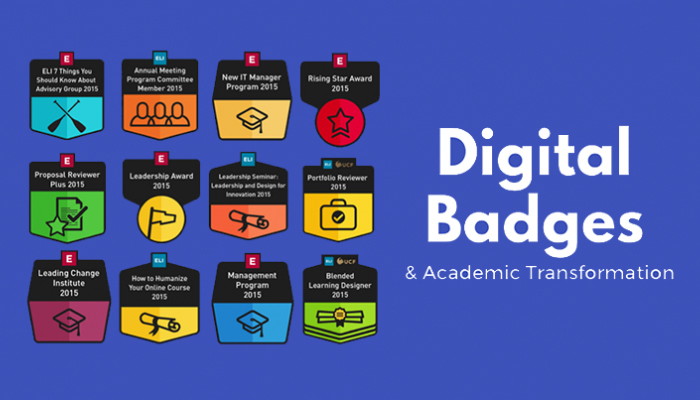
It seems that digital badges are everywhere these days: in fitness apps, on social networking websites, and in company loyalty programs. In higher education, they're taking the form of microcredentials, representing successful completion of a variety of learning experiences inside and outside of the traditional for-credit course.
Institutions continue to experiment with digital badges, and the rate of adoption is increasing at a rapid pace. According to a recent study of 190 institutions by the University Professional Continuing Education Association (UPCEA), one in five colleges has issued digital badges.
We know that both students and institutions are using badges to recognize development of what is called the "T-shaped" graduate: the combination of deep 'vertical' knowledge in a particular domain with a broad set of 'horizontal' skills such as teamwork, communications, facility with data and technology, an appreciation of diverse cultures, and advanced literacy skills.
In today's competitive economy, students and recent graduates are seeking ways to showcase the wide-ranging knowledge and skills they've developed outside of the traditional classroom experience. This learning could take place via internships, co-op programs, community service learning programs, study abroad programs, undergraduate research programs to supplement coursework, or seminars for graduate students, among others.
The Illinois State University Honors Program is an example of how digital badges recognize accomplishments that would never appear on a traditional transcript. Students earn badges for recognition (GPA) – all things that add richness and dimension they can share with potential employers. With some badging platforms now integrating directly with LinkedIn, employers have one more way to explore the skills and abilities of prospective employees.
Another example is Oregon Tech Online, which currently offers more than 20 badges in areas such as Healthcare and Information Technology. Although they've started with courses, they have plans to expand to any assessment-based offering at the institution, including exams, awards, and even the successful completion of a coding boot camp. Digital badges contain searchable tags, and since they can and frequently are posted to social networking sites like LinkedIn, they provide an additional way for employers and recruiters to identify employees who possess desirable skills sets—especially those in quickly changing fields like technology.
The spike in digital badge adoption is not unique to higher education institutions, though. Dell and HP are examples of companies integrating digital badge awards into their internal training programs. Dell's social media and community team launched Social Media and Community University (SMaC U) as an internal training and certification program to teach employees more about the company's social media strategy and practices. Similarly, the Indianapolis-Based CPA Center of Excellence has awarded 271 digital badges for seven courses covering topics like leadership, communications, critical thinking, decision-making, entrepreneurship, collaboration and networking, and social media. All but the last two were identified as core competencies of the CPA profession, and are also widely accepted as vital business skills needed by all business professionals.
As recent as last year, research on badges indicated that while numerous digital badge systems are functioning in many contexts, badges are still not widely valued by hiring officials and therefore not yet widely valued by many learners. Digital badges carry the credibility of the organization that issues them, but another way to enhance their credibility and value is to build them in collaboration with professional societies or associations that are valuable to future professionals and employers. EDUCAUSE is one such example; its award-winning digital badging program includes badges for leadership programs, IT management, and a popular joint badge in blended learning issued in conjunction with the University of Central Florida.
But badges aren't only being created for working professionals or recent graduates. For instance, Planet Stewards [http://dpdproject.info/details/noaa-planet-stewards/] is a badge-driven learning program that guides university science students through an exploration of careers in five categories of Earth sciences. This is a partnership effort by the U.S. National Oceanic and Atmospheric Administration and Boise State University's 3D GameLab, an online learning platform designed around quest-based learning. 3D GameLab developers, headed by Lisa Dawley of GoGo Labs and Chris Haskell of Boise State, partnered with NOAA to offer badges based on NOAA's educational content.
As digital badges become more widely recognized by employers, institutions and students alike, the breadth of learning experiences in which they're offered will likely grow—as will demand. Microcredentials like these could become a strong currency in a job market with requirements that outpace traditional degree programs. (In some fields such as programming, digital badges are already proving to be a competitive advantage.) With lower costs, greater access and less time to completion involved, they may one day rival the once-coveted university degree.
Related resources:
Developing a Higher Education Badging Initiative
10 Lessons Learned in an Award-Winning Digital Badging Program
Digital Badging: The Rise of Skill-Building Recognition at EDUCAUSE
Veronica Diaz is Associate Director, ELI, and Director of Online Programs for EDUCAUSE.
